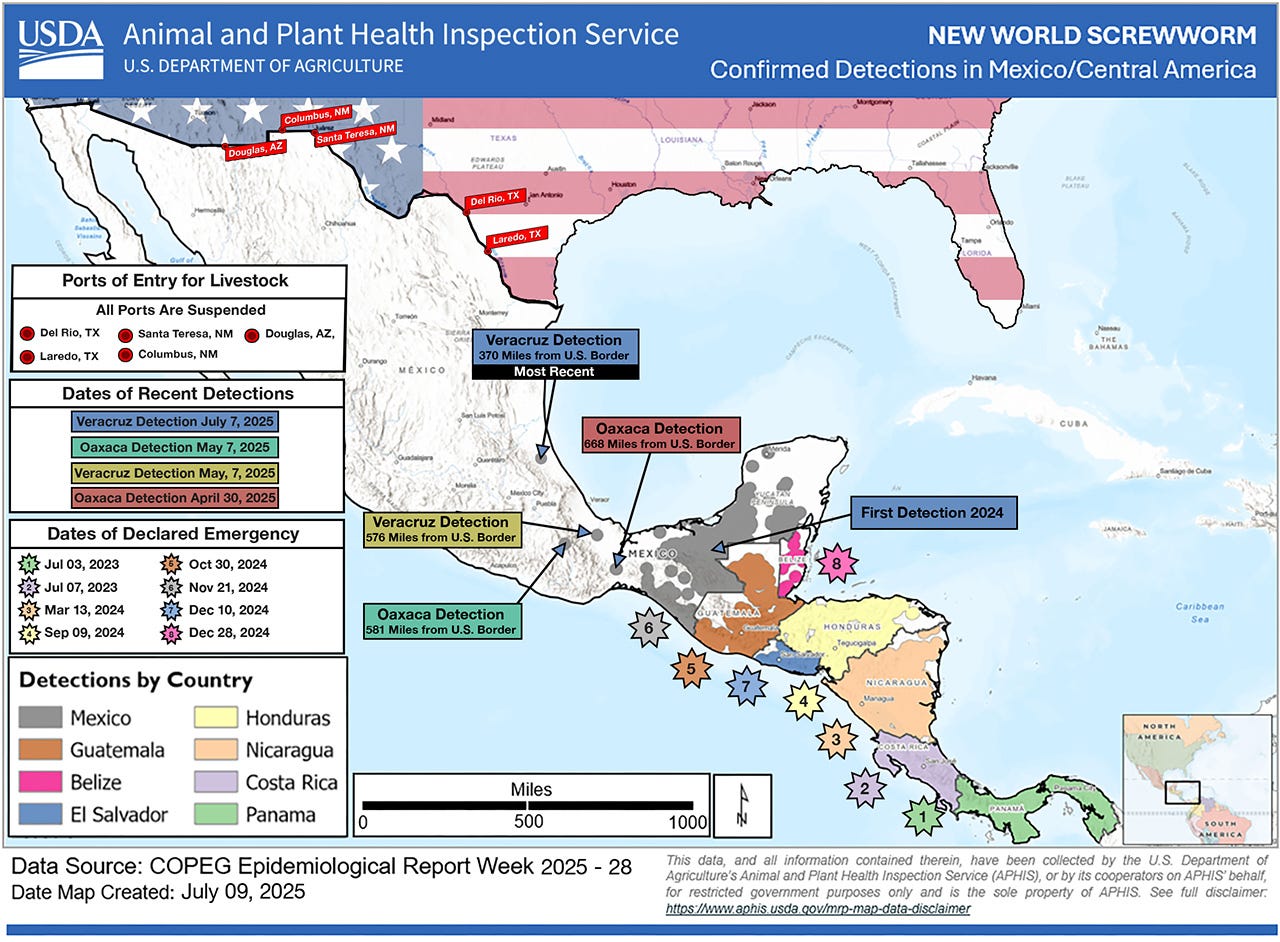USDA Suspends Cattle Imports at Southern Border Over New World Screwworm Threat
Following a new detection in Mexico, the USDA halts livestock trade and expands containment measures to prevent reintroduction of the parasite into the United States.
The U.S. Department of Agriculture (USDA) has reimposed a suspension on livestock imports from northern Mexico following the northward spread of the New World Screwworm fly (Cochliomyia hominivorax), a parasitic insect that poses a serious threat to livestock health and agricultural stability.
What Is the New World Screwworm?
The New World Screwworm is the larval form of a blow fly species native to the Western Hemisphere. Unlike common blow flies that feed on decomposing tissue, screwworm larvae consume living flesh. Female flies lay eggs in open wounds of warm-blooded animals—such as cattle, horses, and wildlife—and the larvae burrow deeper into the tissue, causing severe lesions, infection, and potentially death if untreated.
A History of Containment—and Renewed Border Closures
The New World Screwworm was eradicated from the United States by the 1970s using the Sterile Insect Technique (SIT)—a biological control program that collapsed the population through mass release of sterile male flies. Since then, the parasite had been contained south of the Darien Gap, with Mexico serving as a buffer zone.
However, in late 2024, new screwworm cases were confirmed in southern Mexico, prompting the USDA to suspend livestock imports from Mexico in May 2025. After initial containment progress, the USDA implemented a phased border reopening, with five ports set to resume limited trade between July and September.
That plan has now been reversed. On July 9, following the detection of a new screwworm case in Ixhuatlán de Madero, Veracruz—approximately 160 miles north of the sterile fly dispersal zone and just 370 miles from the Texas border—USDA Secretary Brooke Rollins ordered an immediate reclosure of all livestock trade through U.S. southern border ports. The detection, which raised questions about earlier reporting from Mexican authorities, marks the northernmost advance of the parasite to date.
USDA Response Measures
To contain the screwworm threat, USDA has escalated its response:
Suspension of livestock imports from affected Mexican regions (cattle, bison, equine)
Expansion of the Sterile Insect Technique (SIT), including:
A new $8.5 million sterile fly dispersal facility under construction in South Texas
A $21 million upgrade to the fly production center in Metapa, Mexico
Target capacity: 400–500 million sterile flies released weekly
Aerial release operations over outbreak zones
Design planning for a domestic sterile fly production facility
Strengthened border surveillance and rapid response infrastructure in coordination with Texas, New Mexico, and Arizona
On-site monitoring in Mexico to assess and verify containment measures
If the New World Screwworm crosses into the United States, it could lead to widespread infestations among livestock, resulting in severe animal health impacts, costly quarantines, and disruptions to the agricultural economy and national food supply.
Epidemiologist and Foundation Administrator, McCullough Foundation
www.mcculloughfnd.org
Please consider following both the McCullough Foundation and my personal account on X (formerly Twitter) for further content.





USDA needs to STOP accepting Meat from other Countries, and allowing the Sellers in the US to Repackage and Falsely Label it as From the USA. Very Deceptive to Americans. Also Brooke Rollins Wake Up, STOP MASS vaccinating American Chickens. You Were Warned by Doctors & Scientists NOT TO MASS VACCINATE. Yet You Are proceeding to Mass Vaccinate Anyway. Replace this Moron Rollins, Who Knows Nothing about Pandemics Caused by MassVaccinations.
Sounds bad.
Also sounds incredibly suspicious. .. given all the BS lies we’ve been fed.
Be afraid of chickens and cows!
Not to mention the enormous US food destruction campaign.
- 1 bird with a cold: murder 1 million
- solar farms gobbling up FOOD Farm land.
- And if investors no longer favor solar investments, use taxpayer $ to fund ‘community solar’. (Check our all the bills on this)
Instead let’s have community food farms, cows, and chickens.